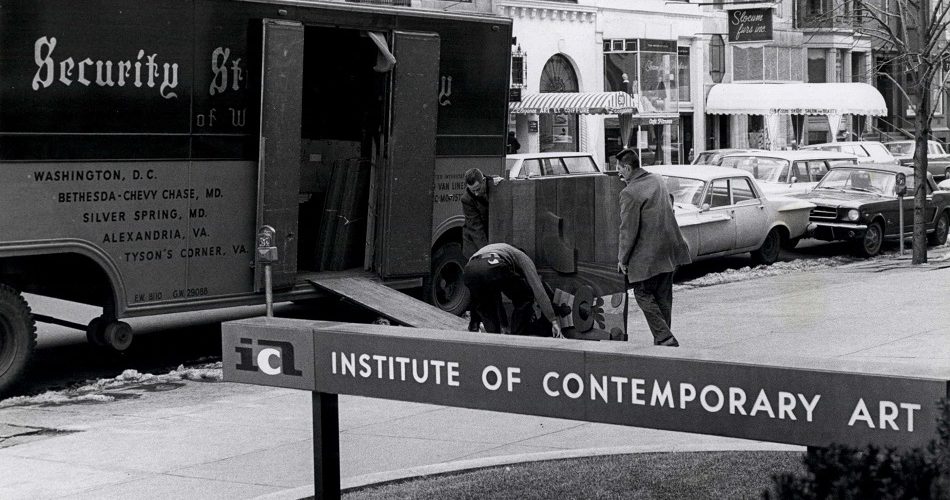
ICA Location 100 Newbury St, 1963
Founded in 1936 as the Boston Museum of Modern Art—a sister institution to New York’s MoMA—the museum was conceived as a laboratory where innovative approaches to art could be championed. The museum established a reputation for identifying important new artists, and in pursuit of this mission, eventually parted ways with MoMA and changed its name to the Institute of Contemporary Art in 1948. As the ICA’s reputation grew around the nation, it paved the way for other institutes and museums of “contemporary art” as well as artists’ spaces and alternative venues.
For 85 years, the ICA has presented contemporary art in all media—visual arts, performance, film, video, and literature—and created educational programs that encourage appreciation for contemporary culture. At the close of the 1990s, several innovative programs strengthened the ICA’s public role, including the teen filmmaking program Fast Forward, and ICA/Vita Brevis, whose temporary installations throughout public spaces in Boston drew critical and popular acclaim. In 2006, the ICA opened its visionary new building, designed by Diller Scofidio + Renfro, on the Boston waterfront. In its new facility, the ICA has expanded the scope and size of its exhibitions and programs—increasing its audiences tenfold and serving as a catalyst for contemporary art in Boston.
Throughout its history the ICA has been at the fore in identifying and supporting the most important artists of its time and bringing them to public attention. Among the artists whose work has been introduced to U.S. audiences by the ICA are Georges Braque, Oskar Kokoschka, and Edvard Munch. Andy Warhol, Robert Rauschenberg, Laurie Anderson, and Roy Lichtenstein were each the subject of ICA presentations early in their careers. More recently, the ICA was pivotal in the careers of numerous visual and performing artists including Bill Viola, Kara Walker, Cildo Meireles, Cindy Sherman, Cornelia Parker, Shepard Fairey, Young Jean Lee, Jay Scheib, Trajal Harrell, and Rashaun Mitchell.
Read more about the ICA’s history.
The ICA incorporates as the Boston Museum of Modern Art, a “renegade offspring of the Museum of Modern Art” in New York (MoMA). Among the oldest museums in the United States dedicated solely to contemporary art, the ICA is led in its earliest years by young architect Nathaniel Saltonstall—then a spry 26 years old—as well as senior trustees W.G. Russell Allen and Thomas N. Metcalf.
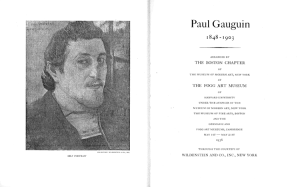
Paul Gauguin catalogue spread, 1936
Offices are rented at 114 State Street, and gallery space is provided by the Fogg and Busch-Reisinger Museums at Harvard University in Cambridge.
The ICA relocates to 14 Newbury Street in Boston. Museum admission is 25 cents.
Leading the way in presenting both visual and performance art, the ICA sponsors the debut performance of the Ballet Russe de Monte Carlo, which includes works produced in collaboration with Pablo Picasso and Henri Matisse.
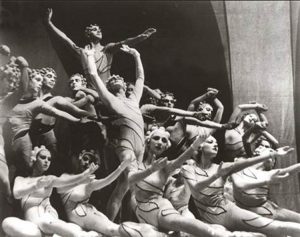
The Ballet Russes de Monte Carlo performing Rouge et noir, choreographed by Leonide Massine, with scenery and costumes by Henri Matisse
The ICA relocates to the Boston Art Club at 270 Dartmouth Street.
James S. Plaut becomes the institution’s first director, defining its identity as an “experimental laboratory” for contemporary art.
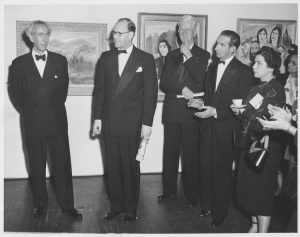
ICA director James Plaut in 1939
The Walker Art Center is founded.
As part of Picasso: Forty Years of His Art—organized by MoMA’s Alfred Barr—the ICA presents the Boston premiere of Picasso’s 1937 antiwar masterpiece Guernica, conceived in response to the Spanish Civil War, all the more timely as World War II sweeps the globe.
The ICA relocates to 210 Beacon Street.
The San Diego Museum of Contemporary Art is founded.
Modern Mexican Painters presents the work of Frida Kahlo, José Clemente Orozco, Diego Rivera, and David Alfaro Siqueiros, among others.
Founding trustees Thomas Metcalf and W.G. Russell Allen step in as acting co-directors while James Plaut leaves Boston to serve in the war. Plaut’s wartime activities (1942–46) include directing the Art Looting Investigation Unit, the intelligence unit of the storied “Monuments Men and Women” responsible for preserving the artistic and cultural achievements of western civilization from the destruction of war and theft by the Nazis.
The first survey in New England of African American artists focuses on the Harlem Renaissance and its legacy, with paintings and sculptures by Romare Bearden and Jacob Lawrence, among others.
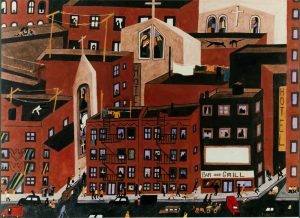
Jacob Lawrence, Harlem, 1942–1943. Artists Rights Society. (ARS).
The ICA relocates to 138 Newbury Street.
The Contemporary Art Museum, Houston is founded.
Setting off heated debate in the art world, the museum changes its name from the Boston Museum of Modern Art to the Institute of Contemporary Art, disassociating itself from “widespread and injurious misunderstandings” the term “modern art” had accrued during the war era and aligning itself instead with the art of the time.
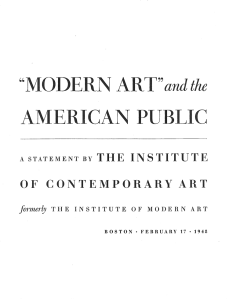
ICA statement, 1948
Six Women Painters from New England presents works by Maud Morgan and I. Rice Pereira, among others, and contests the long-standing under-representation of women in the arts.
Early in the American reception of Edvard Munch, the ICA presents a major career survey that includes the expressionist’s now-iconic work The Scream (1893–1910).
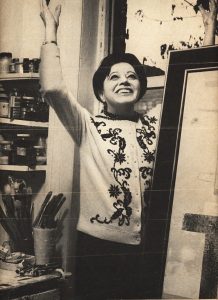
The ICA makes national news with a statement co-signed with the Whitney and MoMA that affirms the dedication of all three museums to the exploration of new frontiers in artistic practice.
A survey of British art since the turn of the century features the work of eminent painter Francis Bacon and the young Lucian Freud, soon to become one of the most distinguished painters of the twentieth century.
A comprehensive traveling exhibition of Bauhaus founder Walter Gropius surveys his formative role in the emergence of modernist architecture and design.
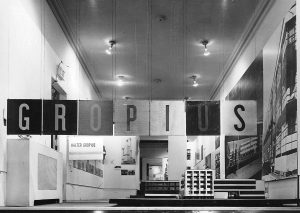
Installation view of Walter Gropius: Approach to Design exhibition, 1952. Photo by Fred Stone.
In one of the earliest U.S. retrospectives dedicated to Wassily Kandinsky, the ICA explores the artist’s foundational role in the development of abstraction, including 52 major paintings, among them 28 never before exhibited in this country.
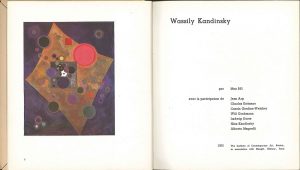
Wassily Kandinsky Catalogue spread, 1952
ICA director James Plaut co-juries the 24th Corcoran Biennial, which travels from Washington, D.C., to Boston, introducing audiences to recent paintings by Adolph Gottlieb and Willem de Kooning, among others.
Thomas Messer is appointed director, serving in that position until 1962.
The ICA hosts The Gulf-Caribbean International, organized by the Houston Museum of Fine Arts, emphasizing the importance of cultural and geographic diversity in contemporary art.
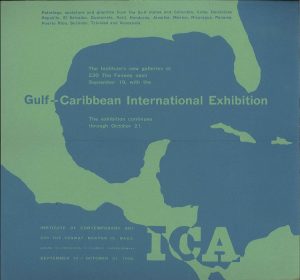
Promotional material for the Gulf-Caribbean International Exhibition, 1956
The ICA moves to new quarters at 230 The Fenway.
The ICA celebrates twenty years at the forefront of contemporary art in Boston with highlights from previous exhibitions.
Selection 1957 inaugurates an annual exhibition program surveying New England artists, organized most years through 1964.
Eminent art historian William Rubin organizes the first U.S. museum survey dedicated to Spanish painter Roberto Matta (sponsored by MoMA in collaboration with the Walker Art Center in Minneapolis and the ICA).
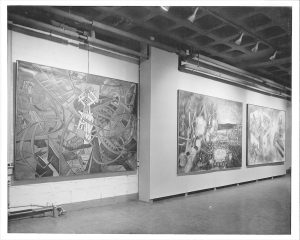
Installation view of Matta, 1958.
Young Talent in New England takes art outside the museum: installed on the walls of a Stop & Shop store on Memorial Drive, the exhibition displays the work of regional artists and anticipates the growing interest in American consumer culture among pop artists such as Claes Oldenburg and Andy Warhol.
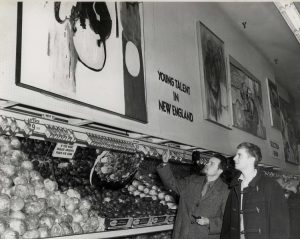
Installation view of Young Talent in New England exhibition, Stop and Shop, 1959
The ICA organizes an unprecedented U.S. museum exhibition dedicated to the career of Viennese expressionist Egon Schiele.
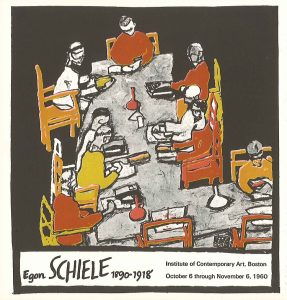
Promotional material for 1960 Egon Schiele exhibition
Newly designed by architect and ICA founder Nathaniel Saltonstall, the Metropolitan Boston Arts Center, at 1175 Soldiers Field Road, becomes the museum’s home for two years.
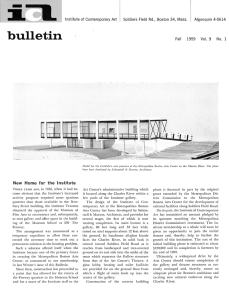
ICA Bulletin from 1959 showing the Nathaniel Saltonstall-designed Metropolitan Boston Arts Center on Soldiers Field Road
The Institute of Contemporary Art, Philadelphia is founded.
The ICA relocates to 100 Newbury Street.
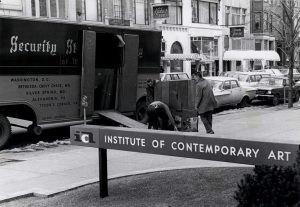
Sign for the ICA Location at 100 Newbury Street in 1963
The 32nd Venice Biennale signals the sensational arrival of American Pop art on the international scene. A concurrent exhibition at the ICA celebrates the artists representing the U.S. in Venice: John Chamberlain, Jim Dine, Jasper Johns, Morris Louis, Kenneth Nland, Claes Oldenburg, Robert Rauschenberg, and Frank Stella.
London: The New Scene, organized by the Walker Art Center, is one of the earliest exhibitions to introduce U.S. audiences to the work of Bridget Riley.
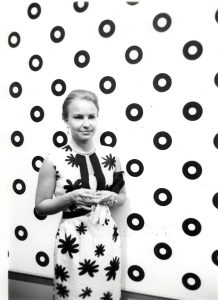
Bridget Riley at the opening of London: The New Scene, 1965
At an early moment in the history of electronic media and video art, Art Turned On brings together some of its leading pioneers, including Dan Flavin, Robert Whitman, and Fluxus artists Ay-O and Joe Jones. Marcel Duchamp attends the exhibition and takes a special interest in Jones’s Music Plant.
Received ideas about mark-making, gesture, and authorship come under scrutiny in Painting Without a Brush, presenting works by Helen Frankenthaler, Morris Louis, Jackson Pollock, Jean Tinguely, and Andy Warhol, among others.
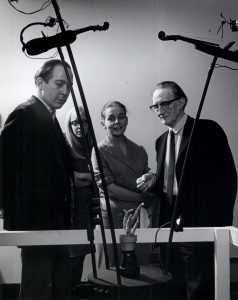
Marcel Duchamp at the opening of Art Turned On, 1965
The ICA organizes the second museum exhibition dedicated to Andy Warhol, with nearly 40 iconic works—soon to become touchstones of 20th-century art history—as well as staging a performance of the landmark intermedia work Exploding Plastic Inevitable by Warhol and the Velvet Underground.
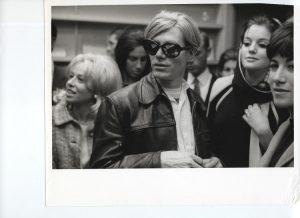
Holly Solomon, Andy Warhol, and International Velvet at the opening of Andy Warhol, 1966
The Museum of Contemporary Art, Chicago is founded.
Andrew Hyde is appointed director and serves in that position until 1974, with a one-year interlude (1971–72) during which artist Christopher Cook leads the organization, with a focus on conceptual art.
The ICA returns to 1175 Soldiers Field Road.
Parkman House at 33 Beacon Street becomes the ICA’s new temporary home.
With the exhibition Monumental Sculpture for Public Spaces, the ICA brings art into the public arena. Outdoor sculptural interventions by Alexander Calder, Donald Judd, Robert Morris, Louise Nevelson, Claes Oldenburg, Mark di Suvero, and others spring up around the city. At City Hall Plaza, Robert Indiana erects a 12-foot-high steel version of his iconic work LOVE.
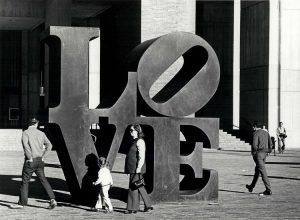
Robert Indiana’s LOVE installed at City Hall Plaza as part of Monumental Sculpture for Public Spaces, 1971
The ICA moves to 137 Newbury Street.
A transformed police headquarters at 955 Boylston Street becomes the ICA’s new home for the next 33 years.
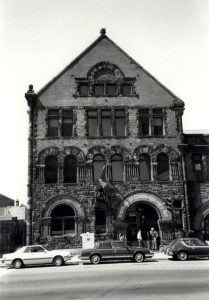
ICA Boylston Street location, 1973
Cambridge sculptor Sydney Rockefeller serves as acting director until the appointment in 1975 of Gabriella Jepson, who serves as director until 1978.
An exhibition observing the rise of postminimalism features work by Ree Morton and Hannah Wilke, among others.
A two-person exhibition pairs paintings by Joan Snyder and Pat Steir.
Photographs, maps, and drawings document Christo and Jeanne-Claude’s Ocean Front (1974), their most recent public intervention. The ICA returns to the couple’s oeuvre in 1979, organizing a major survey of their urban projects.
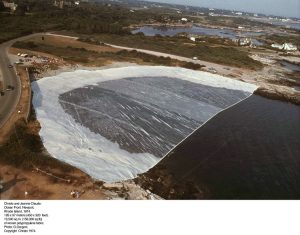
Christo and Jeanne-Claude, Ocean Front, Newport, Rhode Island, 1974. 128×97 meters (430 x 320 feet). 13,500 sq.m (150,000 sq.ft.) of woven polypropylene fabric. Photo by G. Gorgoni. © Christo, 1974
Organized by the ICA and the Walker Art Center, Six Themes offers one of the first major retrospectives of the work of Claes Oldenburg, who attends the exhibition and delivers a public lecture.
The ICA launches the Open City Youth Program, a precursor to the museum’s nationally recognized Teen Arts Education program.
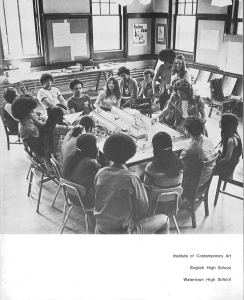
The New Museum is founded.
Stephen Prokopoff joins the ICA as director, serving in that position until 1982.
Modern Works is the first survey to examine Roy Lichtenstein’s shift in 1965 from comics and caroons to canonical works of modernist art as sources for his imagery.
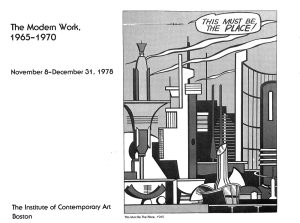
Catalogue for Lichtenstein: The Modern Work, 1965–1970, 1978
Paul Taylor Dance Company performs at the ICA with set and costumes by Boston-based artist Alex Katz.
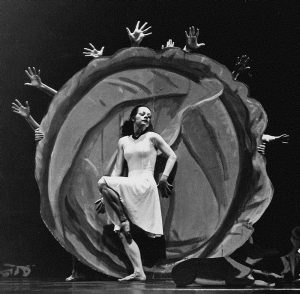
Paul Taylor Dance Company, 1978. Photo by Johan Elbers.
The Museum of Contemporary Art, Los Angeles (LA MOCA) is founded.
The ICA mounts Florine Stettheimer: Still Lifes, Portraits and Pageants, 1910–1942, a successor to her retrospective at Museum of Modern Art in 1946. Stettheimer is recognized as one of the most individualistic American painters of the era between the wars.
David Ross joins the ICA as director, serving in that position until 1990.
The ICA organizes Art and Dance, examining a century of exchange between visual art and dance from 1890 to 1980, featuring works by dozens of artists, including Merce Cunningham, Marcel Duchamp, and Yvonne Rainer.
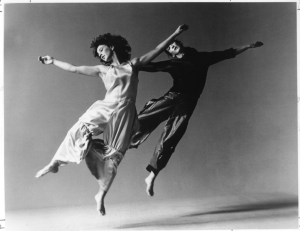
Marta Renzi and Dancers, part of the performance series for Art and Dance: Images of the Modern Dialogue, 1890–1980, 1983
The Pérez Art Museum Miami is founded.
In conjunction with the ICA’s 50th anniversary, the museum launches a landmark project including a major print catalogue and three exhibitions around Dissent: The Issue of Modern Art in Boston. This important project analyzes the distinct attitudes and ideas, during the first half of the 20th century, that set Boston modern art apart from the mainstream as defined by New York City.
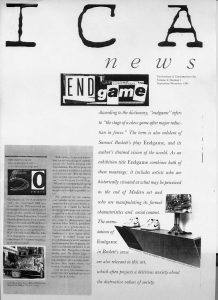
ICA News newsletter, 1996
Pioneering performance and conceptual artist Chris Burden receives his first U.S. museum survey, organized by the Newport Harbor Art Museum and shown at the ICA.
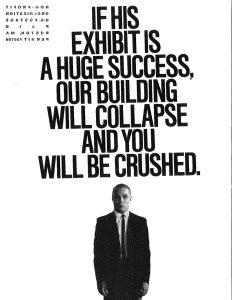
Exhibition announcement for Chris Burden: Twenty Year Survey, 1989
The Hammer Museum is founded.
Robert Mapplethorpe’s first U.S. museum survey culminates at the ICA after traveling nationally from the Institute of Contemporary Art, Philadelphia. At two other venues, the exhibition’s homoerotic content becomes embroiled in a highly visible censorship scandal involving the National Endowment for the Arts, U.S. Congress, and conservative organizations, serving as a cause célèbre for both sides of the Culture Wars. The ICA’s determination to proceed with the exhibition in the midst of this heated debate testifies to its commitment to artists over politics, and to speaking out against censorship.
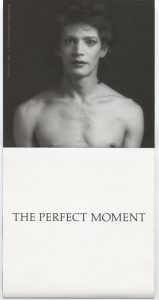
Robert Mapplethorpe exhibition invitation, 1990
Milena Kalinovska joins the ICA as director, serving in that position until 1998.
The Yerba Buena Center for the Arts is founded.
WIth works by such artists as David Hammons and Glenn Ligon, Malcolm X: Man, Ideal, Icon explores the cultural and political legacy of one of the most galvanizing African-American leaders in U.S. history.
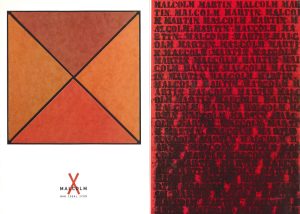
Promotional material for Malcolm X exhibition with Malcolm X by Glenn Ligon at right, 1993
Prominent British artist Rachel Whiteread, recipient of the 1993 Turner Prize, receives her second U.S. museum survey.
The Boston School is the first museum exhibition to identify common threads in the work of Philip-Lorca diCorcia, Nan Goldin, Jack Pierson, Shellburne Thurber, and other photographers living and working in Boston in the late 1970s and the ’80s.
Felix Gonzalez-Torres, Paul McCarthy, and David Wojnarowicz participate in CURRENTS.
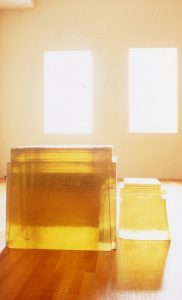
Installation view, Rachel Whiteread, 1995
The ICA introduces Boston audiences to the productions of filmmaker Steve McQueen.
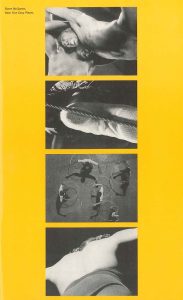
Brochure for Steve McQueen’s Five Easy Pieces, screened at the ICA in 1995
Curated by Catherine de Zegher, Inside the Visible acknowledges under-recognized contributions by women artists in the 20th century, with works by Louise Bourgeois, Lygia Clark, Eva Hesse, Nancy Spero, and Carrie Mae Weems.
New Histories spotlights contemporary artists of African and African American descent whose work addresses the history and daily realities of racism, such as Isaac Julien, Kara Walker, and Fred Wilson.
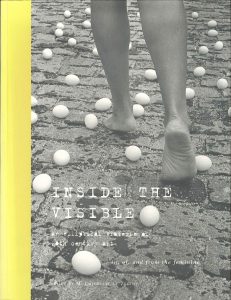
Inside the Visible catalogue cover, 1996
One of Brazil’s most influential contemporary artists, conceptualist Cildo Meireles, receives the first major U.S. museum exhibition of his career.
Enterprise reflects the emergence of Relational Aesthetics (the term first coined in 1996), featuring work by Rikrit Tiravanija, and, in their first U.S. museum show, Vanessa Beecroft and Liam Gillick.
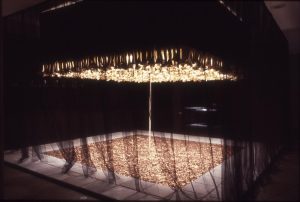
Installation view, Cildo Meireles, 1997
As the 11th director of the ICA, Jill Medvedow brings a bold vision for artistic and civic leadership to the museum, shepherding important exhibitions, programs for teens, and a new home on Boston’s waterfront.
Jill Medvedow launches Vita Brevis at the museum, an ongoing series that commissions local, national, and international artists to create temporary works of art in public settings. Krzysztof Wodiczko and Jim Hodges are among the first artists to receive commissions.
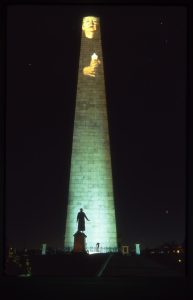
Krzysztof Wodiczko, Bunker Hill Monument Projection, Let Freedom Ring, inaugural ICA/Vita Brevis Project, 1998
The Massachusetts Museum of Contemporary Art (MASS MoCA) opens its doors in North Adams, Massachusetts.
Jim Hodges explores the devastation wrought by the AIDS crisis in one of the first solo museum exhibitions of his career, organized by the Museum of Contemporary Art in Chicago.
African American artist Kerry James Marshall receives his first major U.S. museum exhibition.
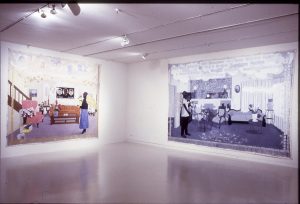
Installation view, Mementos: Kerry James Marshall, 1999
The ICA wins a citywide bid to develop a new building for the museum on Boston’s Fan Pier.
Cornelia Parker receives her first museum solo exhibition in the U.S.
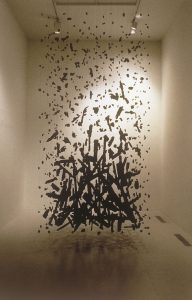
Cornelia Parker, Hanging Fire (Suspected Arson), 1999, Wire mesh, charcoal, wire, pins, nails, 144 x 60 x 72 inches. Gift of Barbara Lee. © Cornelia Parker, courtesy Frith Street Gallery, London.
Olafur Eliasson receives his first U.S. museum solo exhibition. A companion ICA/Vita Brevis project by Eliasson introduces a temporary floating park moored to Boston’s Fan Pier, adjacent to the ICA’s future home at 100 Northern Avenue.
Rineke Dijkstra receives her first U.S. survey.
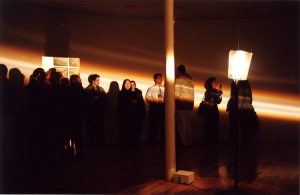
After a competitive selection process, New York architecture firm Diller Scofidio is commissioned to design the new ICA.
The ICA opens its new world-class, 62,000-square-foot building designed by Diller Scofidio + Renfro on Boston’s waterfront, and establishes a permanent collection of 20th- and 21st-century art with works by Paul Chan, Marlene Dumas, Mona Hatoum, Christian Jankowski, and Cornelia Parker.
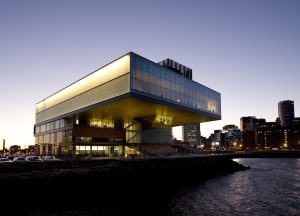
Photo by Peter Vanderwarker
The ICA presents the world premiere of Looky by the Mark Morris Dance Group.
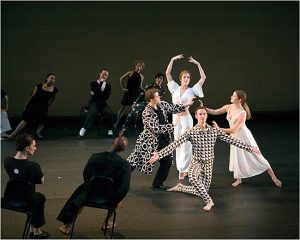
Mark Morris Dance Group performs Looky, 2007.
The ICA organizes Anish Kapoor’s first U.S. museum survey in more than 15 years, and presents the first museum survey of Tara Donovan’s work.
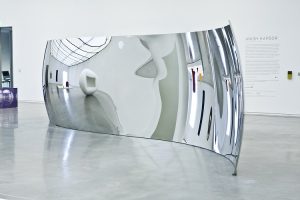
Anish Kapoor, S-Curve, 2008. Photo by John Kennard.
In conjunction with Shepard Fairey: Supply and Demand, the first museum survey of one of the most influential street artists of our time, the artist creates public artworks at sites around Boston and a new mural for the ICA.
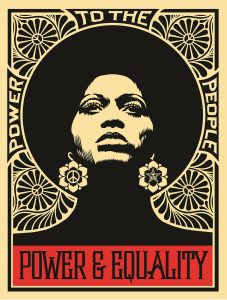
Shepard Fairey, Afrocentric (Power & Equality), 2007. Screenprint, 24 x 18 inches (61 x 45.7 cm). Acquired through the generosity of Beth and Anthony Terrana, Sandra and Gerald S. Fineberg, Fotene Demoulas, and the artist. Courtesy the artist and Obey Giant Art. © Shepard Fairey
Jenny Holzer presents a new text projection on the exterior of the ICA as part of her collaboration with Bessie Award–winning choreographer Miguel Gutierrez.
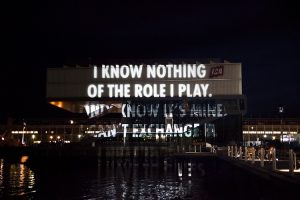
View of Jenny Holzer’s video For Richard and Miguel projected onto the ICA’s exterior in 2010 as part of the series Co Lab: Works & Process
In its 75th-anniversary year, the ICA welcomes its 1 millionth visitor to the new waterfront location and presents Dance/Draw, an ambitious thematic exhibition that investigates the connections between visual art and dance over the past 50 years.
ICA commissions and hosts the world premiere of Body Against Body by the Bill T. Jones/Arnie Zane Dance Company.
First Lady Michelle Obama presents the ICA with the National Arts and Humanities Youth Program Award from the President’s Committee on the Arts and the Humanities, the highest honor awarded to youth programs in the United States.
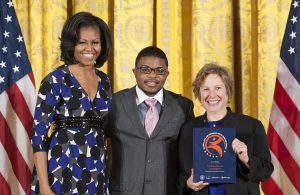
Michelle Obama with ICA Teen participant Romario and director Jill Medvedow
Brazilian twin-brother street artist duo Os Gemeos are the first artists to create a mural on a large Big Dig ventilation structure on the Rose Kennedy Greenway, in partnership with the Greenway Conservancy. The mural, depicting a boy in brightly colored clothing, accompanies the artists’ first solo exhibition in the U.S.
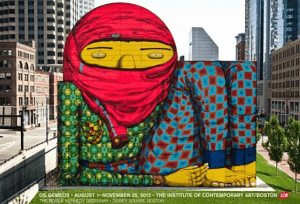
This Will Have Been: Art, Love & Politics in the 1980s, featuring artwork by Jean-Michel Basquiat, Felix Gonzalez-Torres, the Guerrilla Girls, Jeff Koons, Robert Mapplethorpe, Richard Prince, Gerhard Richter, Doris Salcedo, Cindy Sherman, and Tseng Kwong Chi with Keith Haring, receives wide critical acclaim, attracting record crowds.
The ICA establishes The Barbara Lee Collection of Art by Women with a gift of 43 works by 25 international female artists, expanding the museum’s holding by 30 percent. A mix of paintings, photographs, sculptures, and drawings, the collection includes works by Louise Bourgeois, Tara Donovan, Marlene Dumas, Eva Hesse, Yayoi Kusama, Doris Salcedo, and Cindy Sherman, among others.
The influential Fiber: Sculpture 1960–Present considers cultural and critical forces shaping abstract fiber art with works by 34 artists including Magdalena Abakanowicz, Françoise Grossen, Eva Hesse, Sheila Hicks, Lenore Tawney, Rosemarie Trockel, and Haegue Yang.
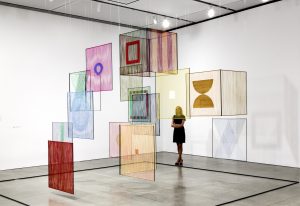
Elsi Giauque, Élément spatial (Spatial Element), 1979. Linen, silk, wool, and metal, twenty frames, each 35 3⁄8 x 37 3⁄8 x 1⁄4 inches. Mudac–Musée de design et d’arts appliqués contemporains, Lausanne, Switzerland. Photo by John Kennard.
In the largest gift ever made to the museum, trustee Barbara Lee donates 20 works by 12 artists to become part of the Barbara Lee Collection of Art by Women including a room-sized installation by Kara Walker exploring the legend of Huckleberry Finn, as well as works by Louise Bourgeois, Carol Bove, Ellen Gallagher, Eva Hesse, and Sherrie Levine.
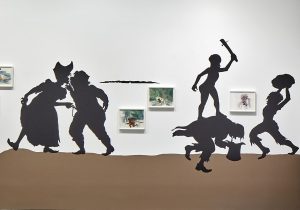
Kara Walker, The Nigger Huck Finn Pursues Happiness Beyond the Narrow Constraints of Your Overdetermined Thesis on Freedom–Drawn and Quartered by Mister Kara Walkerberry, with Condolences to the Authors, 2010. Cut paper and paint on wall; gouache and ink on paper, approximately 57 feet (1737.8 cm) long overall. Sixteen cut paper elements, dimensions variable; seven framed works on paper, each 11 1/2 x 15 inches (29.2 x 38.1 cm). The Barbara Lee Collection of Art by Women. Installation view, First Light: A Decade of Collecting at the ICA, The Institute of Contemporary Art/Boston, 2016-17. Photo by Charles Mayer Photography. © 2016 Kara Walker
Chicago-based artist Diane Simpson presented elegantly constructed, architectural sculptures in her first major museum exhibition (at the age of 80).
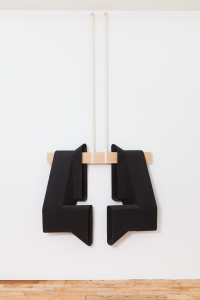
Diane Simpson, Formal Wear, 1998, Polyester, poplar, and cotton, 47 x 50 x 7 inches. Courtesy the artist, Corbett vs. Dempsey, Chicago, and JTT, New York. © 2015 Diane Simpson
The ICA presents Leap Before You Look: Black Mountain College 1933–1957, the first comprehensive museum exhibition on the influential school in the United States. The exhibition features works by more than 90 artists, including Anni and Josef Albers, John Cage, Robert Rauschenberg, Elaine and Willem de Kooning, Buckminster Fuller, Ruth Asawa, Robert Motherwell, Gwendolyn and Jacob Knight Lawrence, Charles Olson, and Robert Creeley, as well as archival materials, a soundscape, and a piano and a dance floor for live performances including recreations of rediscovered work by Merce Cunningham.
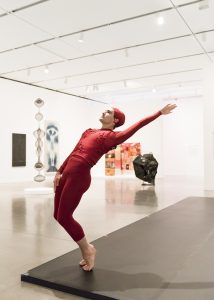
Silas Riener performs Merce Cunningham’s Changeling at the Institute of Contemporary Art/Boston. Photo by Liza Voll.
The ICA presents the first mid-career survey of the work of Boston-born artist Liz Deschenes, whose singular and influential achievements in photography and sculpture consider light, color, and the relationship between the mechanics of seeing, image-making processes, and modes of display.
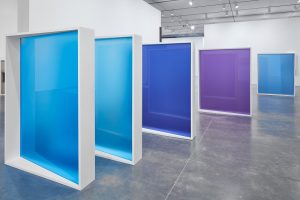
Installation view, Liz Deschenes, Institute of Contemporary Art, Boston, 2016. Charles Mayer Photography. © Liz Deschenes
The ICA organizes the first U.S. survey of the work of artist Mark Dion. Mark Dion: Misadventures of a 21st-Century Naturalist examined 30 years of his pioneering inquiries into how we collect, interpret, and display nature. A highlight of the exhibition, the installation The Library for the Birds of New York/The Library for the Birds of Massachusetts, brought live canaries and finches to the galleries.
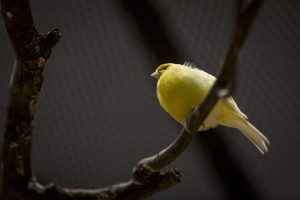
Mark Dion, The Library for the Birds of New York/The Library for the Birds of Massachusetts (detail), 2016/2017. Steel, wood, books, living birds, and found objects, 138 × 240 inches (350.5 × 609.6 cm). Sammlung Migros Museum für Gegenwartskunst, Zurich. Photo by Caitlin Cunningham. © Mark Dion
The ICA opens the ICA Watershed in the Boston Harbor Shipyard and Marina in East Boston, transforming a 15,000-square-foot, formerly condemned space into a vast and welcoming space to see and experience large-scale art. Designed by Anmahian Winton Architects, the new space opened for its first season in June 2018, prompting the City of Boston to declare June 22 ICA Watershed Day.
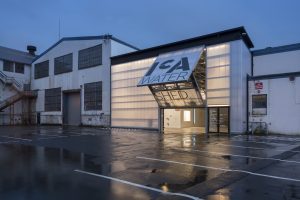
Photo by Florian Holzherr
The ICA hosts Building Brave Spaces: Mobilizing Teen Arts Education, an unprecedented national gathering to reflect and build upon the knowledge and field-wide progress made in teen arts education since the establishment in 2008 of the ICA’s groundbreaking Teen Convenings.
Art in the Age of the Internet, 1989 to Today examines the boundless influence the internet has had on all facets of our lives, from work to dating to privacy to how we understand our bodies and ourselves. Critically acclaimed, the exhibition includes a museum-spanning performance by Ryan McNamara, MEEM 4 Boston: A Story Ballet About the Internet, a citywide Art + Tech collaboration with more than a dozen cultural institutions, and the ICA’s first-ever virtual reality commission, by artist Jon Rafman.
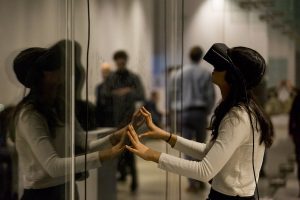
Jon Rafman, View of Harbor, 2017. Virtual reality headsets and 3-D simulation (color, sound; approximately 8:00 minutes), Dimensions variable. Courtesy the artist. Photo by Caitlin Cunningham. © Jon Rafman
The ICA presents the first comprehensive American exhibition of artwork by celebrated choreographer William Forsythe. Visitors are invited to physically interact with the works.
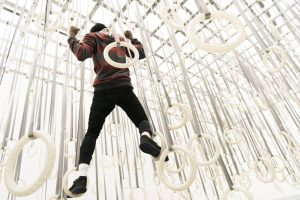
William Forsythe, The Fact of Matter, 2009. Installation view, William Forsythe: Choreographic Objects, the Institute of Contemporary Art/Boston, 2018. Photo by Liza Voll. © William Forsythe
The ICA announces the acquisition of Yayoi Kusama’s LOVE IS CALLING, the largest of her popular Infinity Mirror Rooms to date. Featuring vividly colored, tentacle-like inflatable sculptures covered with the artist’s signature polka dots in an endlessly reflecting mirrored room, LOVE IS CALLING is one of Kusama’s most psychedelic, immersive installations. The ICA exhibited an early Infinity Mirror Room, now titled Endless Love Show, in the exhibition Multiplicity in 1966.
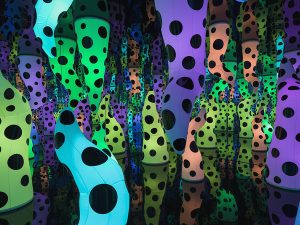
Yayoi Kusama, LOVE IS CALLING, 2013. Wood, metal, mirrored glass, vinyl, ceramic tile, acrylic panel, blowers, lighting elements, speakers, and sound, 174 1/2 x 340 5/8 x 239 3/8 inches (443 x 865 x 608 cm). Acquired through the generosity of Barbara Lee/The Barbara Lee Collection of Art by Women; Fotene Demoulas and Tom Coté; Hilary and Geoffrey Grove; Vivien and Alan Hassenfeld; Jodi and Hal Hess; Barbara H. Lloyd; and an anonymous donor. Courtesy David Zwirner, New York; Ota Fine Arts, Tokyo/Singapore/Shanghai; Victoria Miro, London/Venice. © YAYOI KUSAMA
In the Watershed, John Akomfrah’s Purple, an immersive six-channel video installation co-commissioned by the ICA, makes its U.S. premiere.
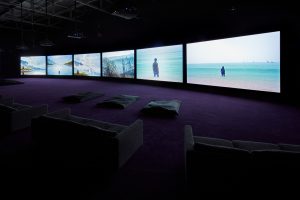
John Akomfrah, Purple, 2017. Six-channel HD video installation with 15.1 surround sound (color, sound; 62:00 minutes), dimensions variable. Collections of the Institute of Contemporary Art/Boston with funds provided through the generosity of the Acquisitions Circle and Erica Gervais Pappendick and Ted Pappendick; and Hirshhorn Museum and Sculpture Garden, Washington, D.C. with funds provided by the Joseph H. Hirshhorn Purchase Fund. Courtesy Lisson Gallery. © Smoking Dog Film
The ICA is selected to commission the U.S. Pavilion at the Venice Biennale with a historic presentation of Simone Leigh, the first Black woman to represent the United States. The works go on view in Boston in 2023 as part of a national tour survey of Leigh’s work.
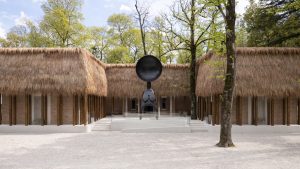
Simone Leigh: Façade, 2022. Thatch, steel, and wood, dimensions variable. Satellite, 2022. Bronze, 24 feet × 10 feet × 7 feet 7 inches (7.3 × 3 × 2.3 m) (overall). Courtesy the artist and Matthew Marks Gallery. Photo by Timothy Schenck. © Simone Leigh